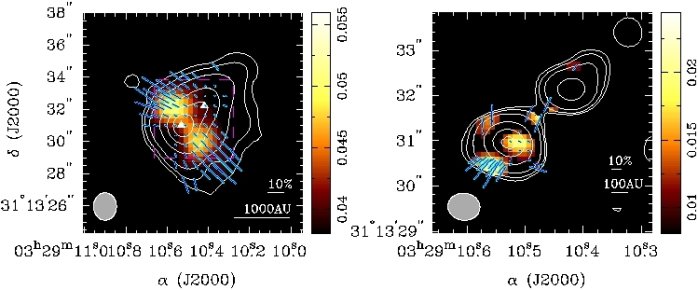| EPoS Contribution |
|
Toroidal Magnetic Field Revealed in the Pseudodisk of NGC1333 IRAS 4A
Shih-Ping Lai National Tsing Hua University, Hsinchu, Taiwan | |
| We present the first map of the toroidal magnetic field structure in a pseudodisk. The magnetic field in the low-mass protostellar core NGC1333 IRAS4A (hereafter IRAS4A) have an hourglass morphology in the scale of few thousands AU. Here we further explore the magnetic field structure within the central 1000 AU region of IRAS4A with the sub-arcsecond resolution dust polarization data taken with SMA at 345 GHz. The SMA observations reveal that except for the regions perpendicular to the center of IRAS4A1, the magnetic field appears to be parallel the protostellar binary, IRAS4A1 and IRAS4A2, and perpendicular to the large scale hourglass structure. We model the observed polarization with a large-scale poloidal (hourglass-like) field and a small-scale toroidal field withing central 1000 AU, and show that the toroidal component is necessary for producing the observed field structure. This modified geometry is in agreement with the expectation of star formation theories with ideal MHD conditions and nonzero angular momentum. | |
 | |
| Caption: This map is made from SMA data taken in the subcompact, compact, and extended array. The contours represent the total intensity (Stokes I) at the level of 3, 5, 10, 30, 60, 90 x 26.2 mJy/beam. The color image shows the polarized intensity. The line segments indicate the magnetic field directions with their lengths proportional to the polarization percentage. The dashed rectangle marks the region presented in the right figure. RIGHT: Same as the LEFT figure, but only visibilities with spatial frequency greater than 75 kilo-wavelength are used. The contours are at 3, 5, 10, 30, 60, 90 x 11.8 mJy/beam. | |
| Collaborators: T.-C. Ching, NTHU, Taiwan J. M. Girart, CSIC-IEEC, Spain R. Rao, ASIAA, Taiwan |
Suggested Session:
Magnetic Fields |

